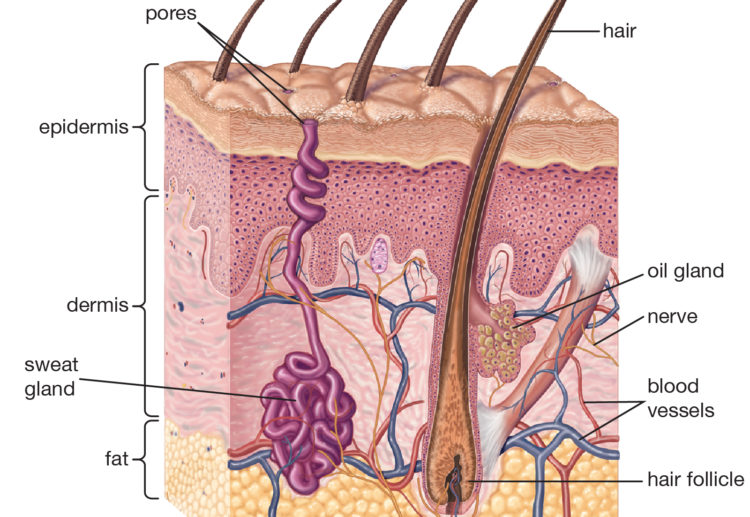
The Endocannabinoid System and Our Skin
April 14, 2021

Our guest writer for today is Zilis Ambassador Dr. Steven E. Todd DMD, MaS. Dr. Todd is an Integrative Sleep Specialist and Clinical Cannabinologist with a master’s degree in Regenerative Medicine. Regenerative Medicine utilizes the body’s ability to repair and regenerate itself through the addition of exogenous stem cells and the body’s innate stem cells.
The skin is the largest organ in the body. The skin’s role is to protect us from various environmental challenges. The skin is both the source and target of several hormones. The skin has its own immune system, its own endocannabinoid system (ECS) and is our largest sensory organ.
The skin consists of three layers:
- Epidermis: This layer is the outermost layer of the skin which is formed by several layers of epithelial cells called keratinocytes which express CB1/CB2 receptors. This compact layer of cells provides the body’s waterproof physical protection barrier against UV radiation, microbial invasion, extreme heat and cold, allergens and chemicals.
- Dermis: This layer consists of hair follicles, sebaceous glands, sweat glands, collagen, nerve fibers and elastin fibers (which give the skin strength and elasticity). This layer of skin is home to several mini-organs called appendages. Continuously rejuvenating hair follicles produce hair, while sebaceous glands provide oily sebum to the skin surface, reinforcing the waterproof barrier of the epidermis. Sweat glands secrete sweat to help regulate the body’s temperature. These appendages also produce various hormones such as steroids, estrogen, testosterone, Vitamin D (a parahormone) and play a role in the skin’s immune system.
- Hypodermis: This layer of skin beneath the dermis is sometimes called the subcutaneous fat, subcutis, or hypodermis layer. This layer provides insulation for your body, keeping you warm; provides cushion against trauma, is highly vascularized and is the layer that attaches your skin to the muscles and tissue below it.
These three layers cannot be compartmentalized. The three layers synergistically work together in the event of any injury to the skin. The simplest and most common injury to the skin is a minor sunburn. This injury facilitates the complete regenerative capacity of the skin. From the point of injury (sunburn), the stages of wound healing are 1) inflammation, 2) proliferation and 3) remodeling. The ECS provides the dominant cellular signaling in all three of these stages of wound healing. Without healthy ECS signaling, scarring and wrinkling can occur.

Cross section skin structures.
The layers of the skin have their own immune system and endocannabinoid system that constantly protect against bacteria, viruses, allergens, and other external factors. These systems are composed of various immune cell types which either live inside the skin or invade when injury has occurred. Most importantly all other skin cell types can join the skin’s immune system to protect and heal the organ when necessary.
The skin synthesizes endocannabinoid molecules anandamide (AEA) and 2-AG by multiple cell types and neural cell types in the epidermis, dermis and hypodermis1, 2. These endocannabinoids are constantly released in specific amounts, depending on the health needs of the skin, resulting in the skin’s endocannabinoid “tone” or readiness of response. The skin’s ECS tone can be balanced or imbalanced. When the ECS tone becomes imbalanced, problems with the health/wellness of the skin arise. The addition of cannabidiol (CBD) and minor cannabinoids such as cannabigerol (CBG) and cannabichromene (CBC) have been shown to help support homeostasis or a balanced ECS skin tone. The skin’s ECS tone constantly effects all compartments of the skin, as endocannabinoids act on various cell types and contribute to their healthy physiological function.
Endocannabinoids act on various receptors in the body. The classic CB1 and CB2 receptors are present in practically all cell types of the skin. Activation of endocannabinoid receptors by endocannabinoid neurotransmitters on epidermal cells regulates normal function of the skin as a barrier. When CB1 or CB2 receptors are engaged, the functions of epidermal cells are modified, whether through proliferation (cell growth through multiplication and division), differentiation (changing of cell type- usually to a more specialized cell), or apoptosis (programed cell death). These functions are all important processes for the healthy physical defense of the body. Interestingly, recent research has demonstrated the ability of endocannabinoids to suppress inflammation in the epidermis3.

The ECS’ role in the skin’s immunity is to constantly modulate the activity of the skin’s immune and inflammatory system. The skin’s ECS prevents the activation of the immune system when it is not needed but allows for increased inflammatory activity when called for. CBD, CBC and CBG increase the activity of the skin’s immune system and hold promise for modulating excessive inflammation and excessive immune response in the skin3, 4.
Hair follicles’ lifelong cycle of growth:
Hair follicles exhibit a lifelong cycle of growth, regression, and resting phases. Activation of CB1 receptors plays a major role in cell division or proliferation of hair follicles. Modulation of the ECS activity with CBD, CBC, CBG, may provide promise for hair growth disorders5.
The endocannabinoid tone is also key in the healthy biology of the sebaceous glands (which secrete oily matter called sebum). When the ECS is not properly functioning, the glands are unable to secrete enough lipid-containing sebum and the skin’s waterproof barrier may be weakened, increasing the potential for microbes to invade the body. If the ECS tone of the glands is kept in balance, it can support homeostasis and healthy skin6.

The ECS is also expressed in sweat glands. CB1 and CB2 receptors were found to regulate the life cycle of sweat glands. Additional cannabinoid-like receptors, transient receptor potential vanilloid 1 (TRPV-1) and G protein-coupled receptor 55 (GPR-55), interact with the sweat glands and the endocannabinoid system for thermal regulation of the body7,8.
Activation of the ECS CB1/CB2 receptors on sensory nerve endings in the skin can modulate the function of the afferent (receiving) and efferent (sending) nerve endings. Most importantly, when painful stimuli touch the skin, it is the ECS tone that inhibits the development and spread of pain, thereby easing the body’s suffering. The skin’s ECS effectively suppresses the unpleasant sensation of “itch” which is the most frequently diagnosed symptom in a dermatology practice9.

The skin is the body’s largest organ and consists of three layers – epidermis, dermis, hypodermis. Each layer has specific components and functions, but all three layers work together synergistically in the event of any injury to the skin. The ECS provides the dominant cellular signaling in the stages of wound healing in the skin and exerts anti-inflammatory effects to protect the skin. A healthy ECS skin “tone” supports the skin’s immune system, the function of hair follicles and sebaceous glands as well as the protective skin barrier and sweat glands.
†These products and these statements have not been tested, evaluated, or approved by the U.S. Food and Drug Administration for safety or efficacy. These products and these statements are not intended to diagnose, treat, cure, or prevent any disease.
- Bíró T, Tóth BI, Haskó G, Paus R, Pacher P. The endocannabinoid system of the skin in health and disease: novel perspectives and therapeutic opportunities. Trends Pharmacol Sci. 2009 Aug;30(8):411-20. doi: 10.1016/j.tips.2009.05.004. Epub 2009 Jul 14. PMID: 19608284; PMCID: PMC2757311.
- Correia-Sá, I.B., Carvalho, C.M., Serrão, P.V. et al.A new role for anandamide: defective link between the systemic and skin endocannabinoid systems in hypertrophic human wound healing. Sci Rep 10, 11134 (2020). https://doi.org/10.1038/s41598-020-68058-3.
- Scheau, C., Badarau, I. A., Mihai, L. G., Scheau, A. E., Costache, D. O., Constantin, C., Calina, D., Caruntu, C., Costache, R. S., & Caruntu, A. (2020). Cannabinoids in the Pathophysiology of Skin Inflammation. Molecules (Basel, Switzerland), 25(3), 652. https://doi.org/10.3390/molecules25030652
- Scheau, C., Badarau, I. A., Mihai, L. G., Scheau, A. E., Costache, D. O., Constantin, C., Calina, D., Caruntu, C., Costache, R. S., & Caruntu, A. (2020). Cannabinoids in the Pathophysiology of Skin Inflammation. Molecules (Basel, Switzerland), 25(3), 652. https://doi.org/10.3390/molecules25030652
- Telek A, Bíró T, Bodó E, Tóth BI, Borbíró I, Kunos G, Paus R. Inhibition of human hair follicle growth by endo- and exocannabinoids. FASEB J. 2007 Nov;21(13):3534-41. doi: 10.1096/fj.06-7689com. Epub 2007 Jun 12. PMID: 17567570.
- Czifra G, Szöllősi AG, Tóth BI, Demaude J, Bouez C, Breton L, Bíró T. Endocannabinoids regulate growth and survival of human eccrine sweat gland-derived epithelial cells. J Invest Dermatol. 2012 Aug;132(8):1967-76. doi: 10.1038/jid.2012.118. Epub 2012 Apr 19. PMID: 22513781.
- Zou, S., & Kumar, U. (2018). Cannabinoid Receptors and the Endocannabinoid System: Signaling and Function in the Central Nervous System. International journal of molecular sciences, 19(3), 833. https://doi.org/10.3390/ijms19030833
- Tóth KF, Ádám D, Bíró T, Oláh A. Cannabinoid Signaling in the Skin: Therapeutic Potential of the “C(ut)annabinoid” System. Molecules. 2019 Mar 6;24(5):918. doi: 10.3390/molecules24050918. PMID: 30845666; PMCID: PMC6429381.
- Bíró, T., Tóth, B. I., Haskó, G., Paus, R., & Pacher, P. (2009). The endocannabinoid system of the skin in health and disease: novel perspectives and therapeutic opportunities. Trends in pharmacological sciences, 30(8), 411–420. https://doi.org/10.1016/j.tips.2009.05.004
About Zilis’ Scientific Research & Development Department:
Our Scientific Research and Development Department is headed up by Dr. Marielle Weintraub, a hemp industry expert. She holds a master’s and a PhD in Behavioral Neuroscience and is very active in many dietary supplement and hemp industry trade associations, including her role as the current President of the U.S. Hemp Authority. Dr. Weintraub is committed to the continued development of hemp-specific information and testing to fulfill the Zilis mission.
Zilis is the creator of UltraCell™, a CBD oil product derived from hemp. Based in Argyle, Texas, a suburb of Dallas-Fort Worth, Zilis is privately held. Visit zilis.com for more information.
SHARE THIS POST
ABOUT THIS BLOG
Discover : The blog with the lifestyle, nutrition, science, and history of the hemp industry.
It’s your go-to for the most up-to-date information on hemp, CBD, dietary supplements, and more! Check it out!







